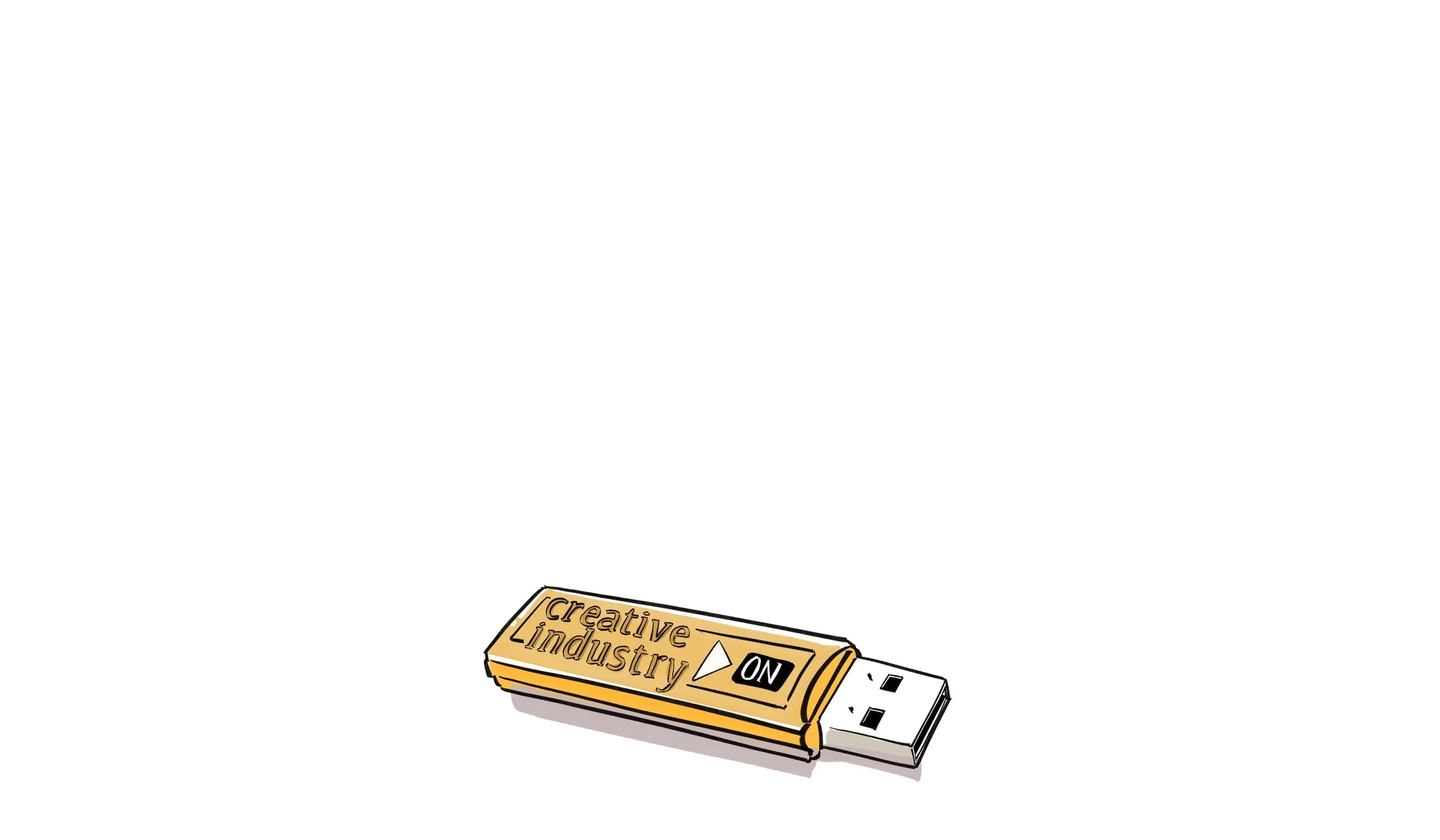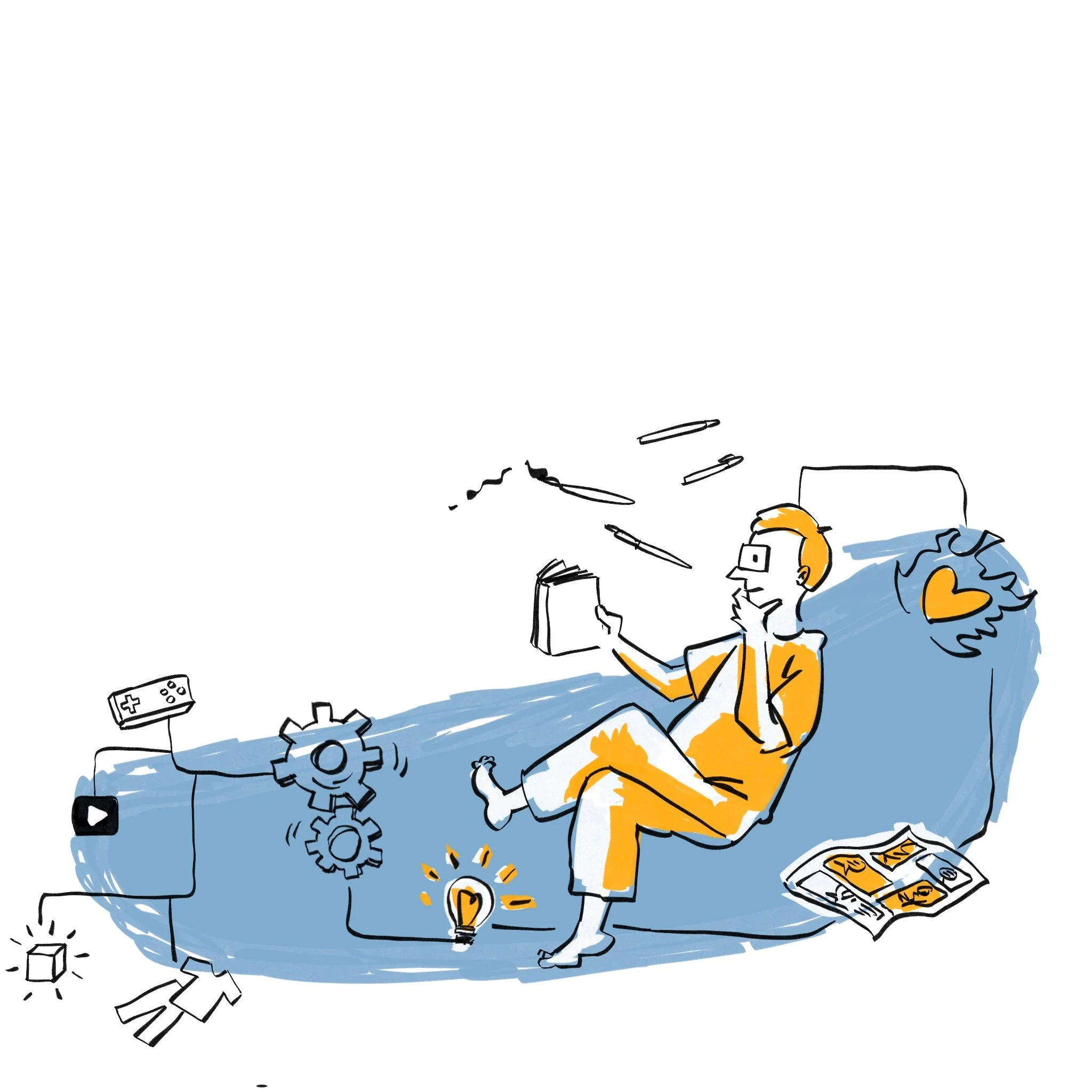how the creative economy flew to indonesia
The term "creative industry" had been recognized since 2008 when Indonesia started to realize an untapped potential in making an economic system utilizing culture and ideas (Elka Pangestu et al., n.d.; Srimulyati et al., 2017). The government also adopted the definition in accordance with the UK's DCMS (The Department of Culture, Media, and Sports) as, "those industries in which have their origin in individual creativity, skill and talent and which have the potential to wealth and job creation through the generation and exploitation of intellectual property."
Illustration: Creative Industry as a transferrable file. Copyright: Gideon Hutapea
Prior to that, the creative economy in Indonesia had already begun to be discussed frequently (although exclusively in the government's discourse) followed with the launch of Indonesia Design Power program in 2006 (Purnomo, 2016). This program initiated by the Ministry of Trade was designed to increase Indonesian products' competitiveness in the domestic overseas market but within the limited scope of product design, packaging design, fashion design, architecture, and interior design.
Despite its long recognition of what will be a "creative industry," the idea is far-sighted, the activities are sporadic, and no single authoritative governmental document to integrate it into national economic system. This 'creative economy' discourse conceived from Indonesia's participation in the UK-East Asia Creative Cities Forum in Yokohama Japan in 2007 (Maryunani & Mirzanti, 2015). The forum which scheduled to promote debate, exchange interactions, and explore how art, culture, in the city scope managed to develop knowledge economies. Bandung was chosen as the pilot project for the creative industry mapping with a joint research collaboration by the UK's Task Force and local academia, especially the Bandung Institute of Technology (ITB).
Normatively, creative industries are clustered in big cities, where they can benefit from a large market and various activities (Fahmi et al., 2016b). Diversity is also one of the most important aspects of creative clusters, according to (Angelopoulos, 2016; Florida, 2003; Ren et al., 2023; Sasaki, 2010; UNESCO & Global Alliance for Cultural Diversity, n.d.; Yoshimoto, 2009). There is no question that regional and social economic arrangements are crucial to the creative industry, and that these characteristics create conditions enhancing creativity and entrepreneurship (Easton & Djumalieva, 2018; Florida, 2003; Loy & Aageson, 2018; E. Rahmawati & Dessy Irawati, n.d.; UNESCO & World Bank, 2021). And considering all these aspects, to choose Bandung as the recipient if such mapping is justified.
According to Simatupang(Simatupang et al., 2012), research taken by DCMS UK in Bandung, Indonesia in 2008 is the first and remain the most important point of contact between Indonesia and the "creative economy" idea. The Ministry of Trade then released the first official government document entitled "Indonesia Creative Economy Development 2025: Development Plan 2009-2015" for the Indonesian economic approach. The result of DCMS’s mapping itself is not made public, but reflected in this document. Fahmi (Zul Fahmi, 2016) states that the blueprint for the Indonesian Creative Economy launched in 2008 aimed at four objectives; the first was to increase the awareness of Indonesians of local cultural wisdom as a basis for creating economic development.
This document mentioned about the 14 sub-sectors (largely identic to the UK's mapping), definition, on and mission, inter-sectoral model of collaboration (triple-helix), roadmap, goals, comparative studies and future recommendations. This document wasn't intended as working plan, but more of a guide to be translated and executed by related departments and local governments (Ministry of Trade Republic of Indonesia, 2008).
Since then, from 2008-2011, Ministry of Trade Republic of Indonesia became the overseer of the creative economy narratives. It was clear that the creative economy narrative was only a prototype intended for Bandung; but then magnified into a national scale, unrecognizing the geo-socio-cultural-political complexities within the archipelago.
Elka Pangestu, M., Perdagangan Pengarah Ardiansyah Parman, M. R., Bachrul Chairi Erwidodo Hesti Indah Kresnarini Eddy Suseno, S., & Ernawati Dea Sudarman Hastjarjo Boedi Wibowo Poltak Ambarita Tim Studi, G. (n.d.). STUDI INDUSTRI KREATIF INDONESIA 2008 © Departemen Perdagangan RI Kelompok Kerja Indonesia Design Power-Departemen Perdagangan Penasehat.
Fahmi, F. Z., Koster, S., & van Dijk, J. (2016a). The location of creative industries in a developing country: The case of Indonesia. Cities , 59 , 66 79.https://doi.org/10.1016/j.cities.2016.06.005
Maryunani, S. R., & Mirzanti, I. R. (2015). The Development of Entrepreneurship in Creative Industries with Reference to Bandung as a Creative City. Procedia - Social and Behavioral Sciences, 169, 387–394. https://doi.org/10.1016/j.sbspro.2015.01.324
Purnomo, R. A. (2016). Ekonomi Kreatif: Pilar Pembangunan Indonesia.
Simatupang, T., Simatupang, T. M., Rustiadi, S., & Bob Situmorang, D. M. (2012).Enhancing the Competitiveness of the Creative Services Sectors in Indonesia. In Indonesia’s Report on Creative Services (Vol. 1, pp. 173–270). https://www.researchgate.net/publication/233994138
Srimulyati, T., Azrimultiya, V., Author, C., & Srimulyati, -Toti. (2017). CREATIVE ECONOMY/CREATIVE INDUSTRY DEVELOPMENT IN INDONESIA. In International Journal of Innovative and Applied Research (Vol. 5, Issue 5). http://www.journalijiar.com
Illustration: The creative economy ecosystem. Copyright: Gideon Hutapea


